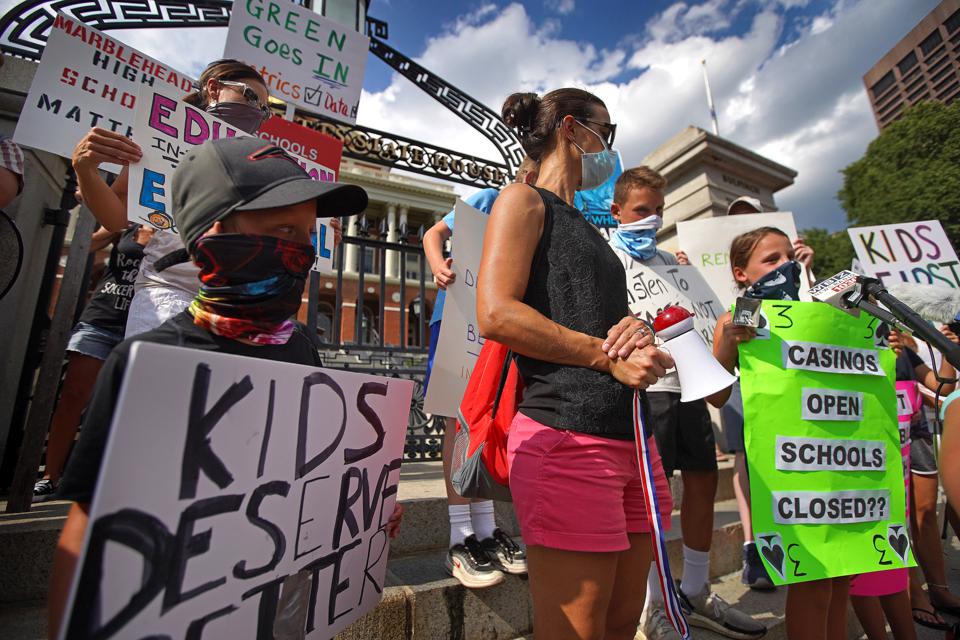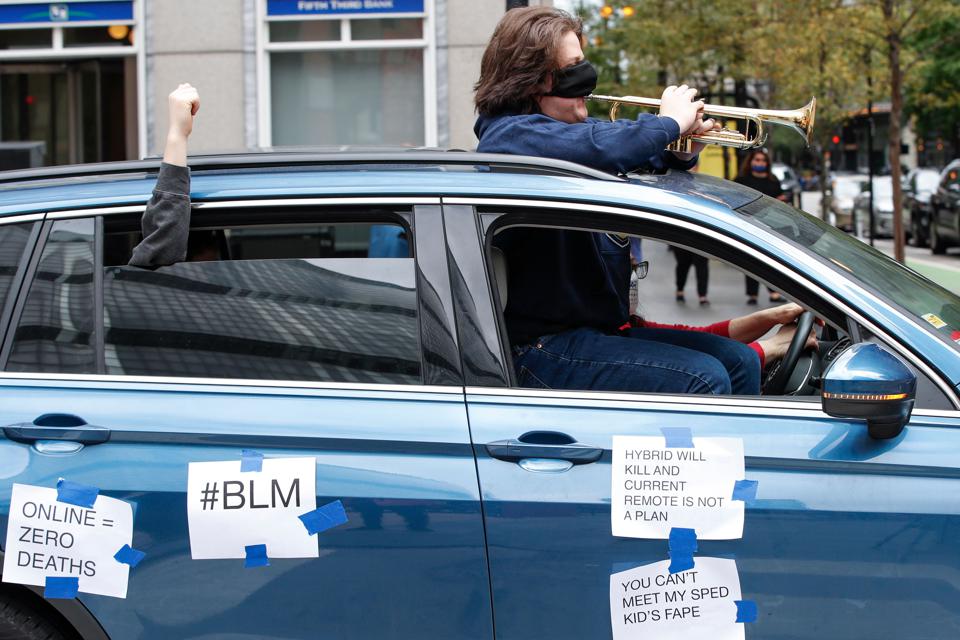The Latest In The School Reopening Saga

THE LATEST IN THE SCHOOL REOPENING SAGA
THE POLITICS OF REOPENING ARE BEGINNING TO CHANGE.
Forbes | August 14, 2020
By Jeanne Allen, Founder and CEO of CER

BOSTON – AUGUST 12: Families attend a Make Way for Education rally for in-person learning at the Massachusetts State House in Boston on Aug. 12, 2020. Parents and students protest to go back to school during the coronavirus pandemic. (Photo by Barry Chin/The Boston Globe via Getty Images)
The push to reopen school reached a new level this week as mayors and governors on both sides of the aisle, as well as the president, began to push for physical school reopenings in the absence of “proof” that they cannot open safely. This is a major change from just last week, when most leaders were being intimidated by unions and other education associations into opening virtually only, but late.
The shift transcends political party allegiance, something rare in education debates in recent years.
While President Trump was taking the stage to promote physical reopenings at a White House event with parents, teachers and education leaders who agree, New Jersey Governor Phil Murphy was making his case that schools must first demonstrate that they cannot open in person to be permitted to open strictly online. “There’s got to be a reason for it,” he said.
As Connecticut Democrat Ned Lamont told CBS’ Face the Nation last week, “I do not want a lost year. When everybody says, ‘Let’s not go back to school until it is perfectly safe, until we have a vaccine, until 100 percent of the people are vaccinated,’ I worry that could be a lost year of education.”
And Rhode Island Governor Gina Raimondo said the Warwick School Committee (the school board) “threw in the towel on kids” this week when they opted to start entirely remotely. “I could not be more disappointed in the vote that they took,” said Raimondo. She favors waiting until the final days of August and making a decision on 5 different data points before making any decision.
She’s right to do that. Educational experts, clinicians and doctors all agree that students need to continuously be learning to ensure their readiness and progress.
District of Columbia Mayor Muriel Bowser recently acknowledged that “children are better served in their classrooms, with their teachers and their peers, and none of us know the impact of having our kids out of school for up to a year. We can guess, we can probably estimate. But I think we all know that it’s not ideal for learning, both academically and social and emotionally.” Despite that, the city is delaying in-person schooling for DC public schools until November 6th – putting many families in great distress.
It’s impractical and wrong to make policies on reopening the same for every community, as if Covid affected every street, school, town, and region in the same way. Policies can be made and resources directed to help based on the different needs and wants that each family has for their children.
“Instructional time, where students can connect with their teacher, is the most valuable resource the district has, but LAUSD is signing away over 7 million instructional hours,” Seth Litt, executive director of the local advocacy group Parent Revolution told the Los Angeles Times. Of the union’s demand that they work fewer hours online and not physically at all for sometime, Litt said, “This is a bad deal for students, and every (school) board member should vote no.”
The best solution for everyone is to create no one solution for all. It’s to encourage a vast array of solutions. Schools that understand this are putting parents first, making decisions based on their own student populations and using technology and innovative approaches to vary their offerings.
Take the Owl Labs’ cameras, which until now have largely been used for business meetings. Renaissance Charter School in Cooper City, Florida, a Charter Schools USA network school, is using the Owl to create a more immersive, interactive experience for students, as well their instructors, utilizing features that don’t require a teacher to be tethered to their computer during instruction, as well as the capacity to more efficiently support instructional sessions in a hybrid setting, with a part in-classroom class successfully engaging with their peers learning remotely, in real-time.
The wide variety of educational options being afforded to parents can be seen particularly in communities where charter schools are well-established. The DC Public Charter School Board, the District of Columbia’s governing authority for charters, has a whole website that lists in detail what each school is doing, providing both transparency and understanding to the communities they serve.
While most are following the city’s model of virtual learning through November 6 – mainly because many DC families have kids in different kinds of schools and rely on public transportation which has been scaled back – others are using their flexibility to operate hybrids or opening in person. Meridian Public Charter School, I Dream Public Charter School, Perry Street Preparatory Public Charter School and IDEA Public Charter School are among the schools offering parents a choice. And while we all want kids to go back in person, the best decision that schools can make is to follow that model and offer parents options.
Contrary to what the president said this week – which is ironically similar to the point of view of teachers unions – virtual or remote learning can be incredibly effective for all sorts of kids and situations. But what schools did in March was anything but effective virtual education. It was crisis education, as the experts have argued, and because traditional education leaders have been critical and often antagonistic to virtual schools, they have not taken time to learn the power of online education, done well, nor ensure that teachers receive training to do so.
So, to put poor kids in a position of further disadvantage if their school has not yet mastered the art and science of virtual learning, basing those decisions on generalized conditions of communities or states, is bad policy and bad for kids. Whether and how schools reopen should be a school by school decision, predicated on the kinds of programs, quality and abilities (frankly) of the staff to deliver education effectively and safely to small groups in person or online.

A protestor plays the trumpet through the sunroof of her car as it drives in the Occupy City Hall Protest and Car Caravan hosted by Chicago Teachers Union in Chicago, Illinois, on August 3, 2020. – Teachers and activists hold car caravan all over the country on August 3, 2020 to demand adequate classroom safety measures as schools debate reopening. (Photo by KAMIL KRZACZYNSKI / AFP) (Photo by KAMIL KRZACZYNSKI/AFP via Getty Images)
Meanwhile national teachers union leadership continues to press for “guarantees” of safety prior to reopening to ward off strikes. They are also stepping up their political posturing to extract enormous and unrelated concessions in exchange for “consenting” to opening, like big tax hikes and moratoriums on more choices for kids. It’s important to note that teachers unions do not have the legal authority to decide if schools open or teachers go back or not. What they have is the power of their labor contract to control teacher behavior. They are putting fear in their members,casting doubt on well-constructed plans and bracing them for walkouts. And that’s what has many governors fuming as they struggle with both educational effectiveness and public safety.
Following a one-size-fits-all mentality, Massachusetts unions are among those that have already succeeded in delaying school opening start dates and are now pressing local school boards to comply with their approach to how and when schools open. According to the Boston Globe, “Boston Teachers Union President Jessica Tang, in a statementlast week, rejected Boston Public Schools’ option for a mix of remote and in-person learning to start the coming school year, calling for ‘a phased-in return to any in-person learning only when all safety protocols are in place and verified.’”
But where does that leave families, particularly those with lesser means, who not only do not have the adequate tools and resources to support their kids but the teachers who are also parents? Surveys suggest that most parents want their kids to return and increasingly the science suggests that the proper combination of social distancing, safety, using outdoors and a myriad of other suggestions from the CDC and medical professionals can protect the employees who are more at risk than children.
With infinite diversity of need, situation and talent, who and where students are matters, something that increasingly the nation’s leaders are appearing to recognize.
Follow Jeanne on Twitter or LinkedIn or some of her other work here.
Founded in 1993, the Center for Education Reform aims to expand educational opportunities that lead to improved economic outcomes for all Americans — particularly our youth — ensuring that conditions are ripe for innovation, freedom and flexibility throughout U.S. education.














